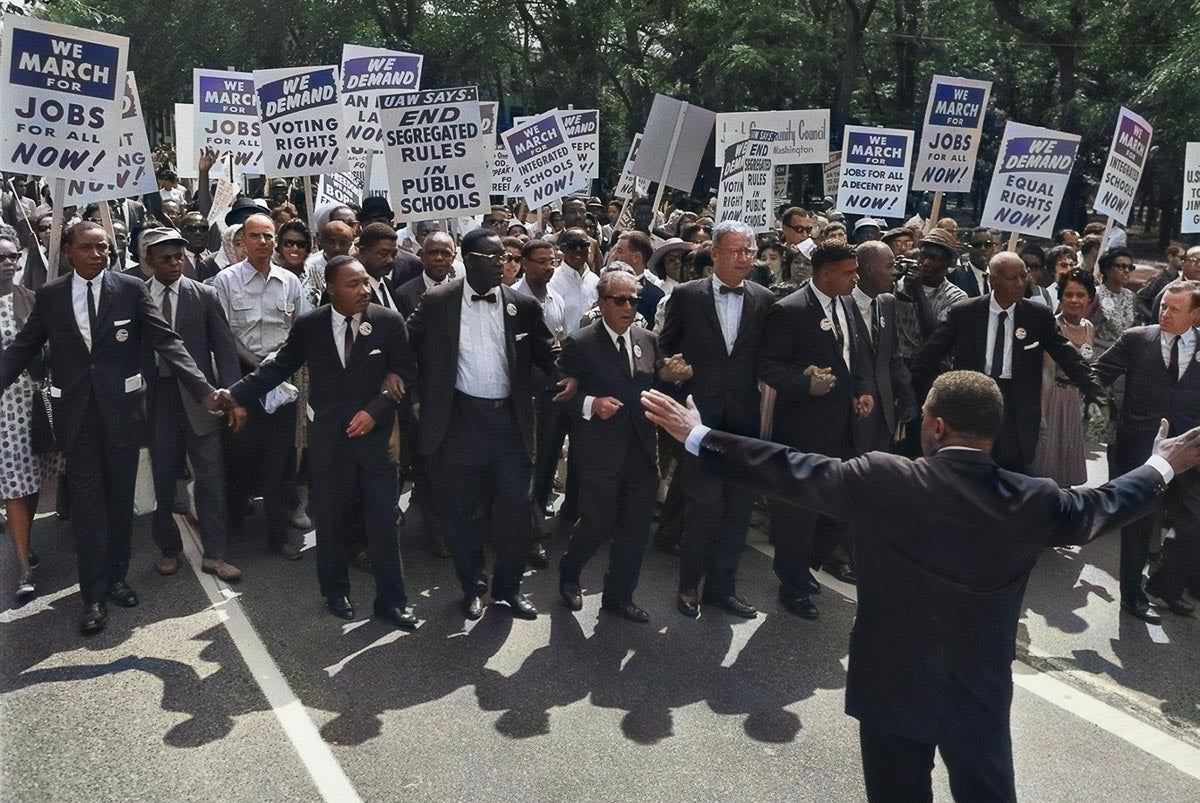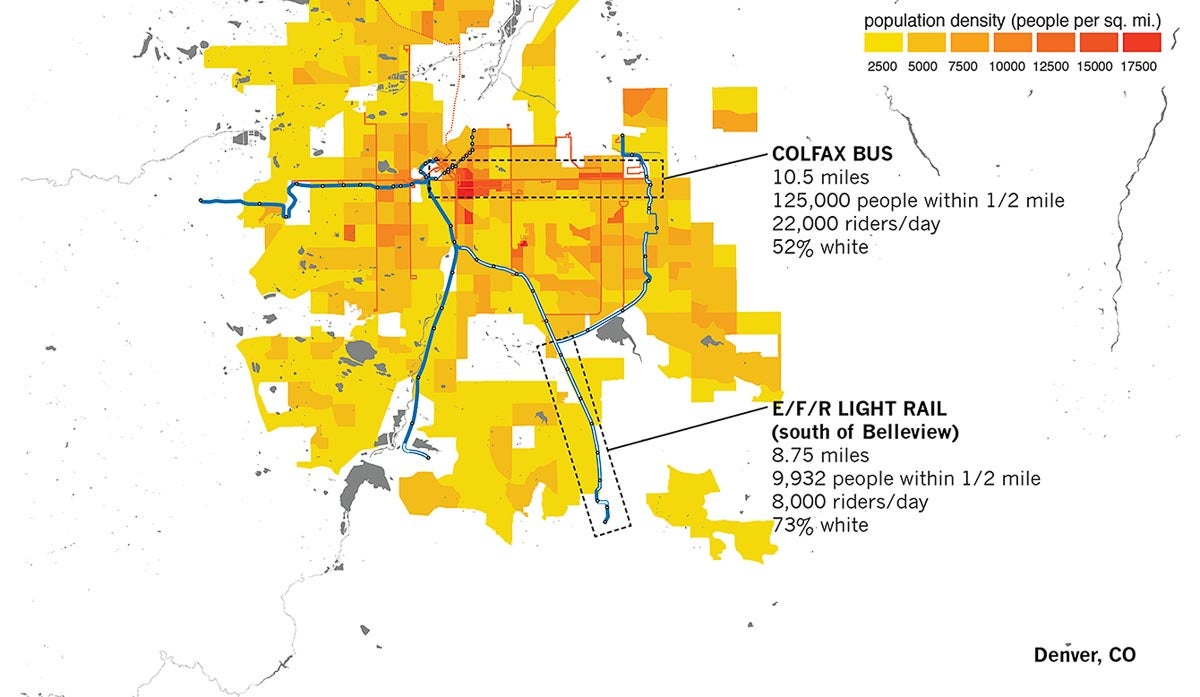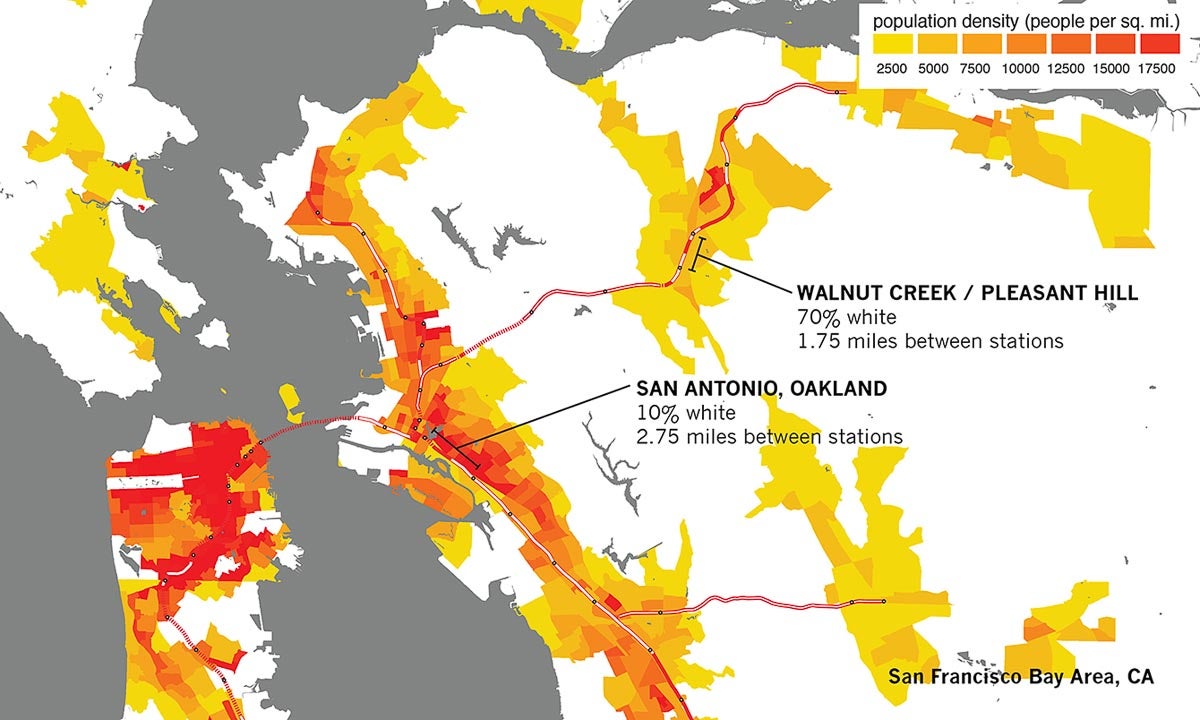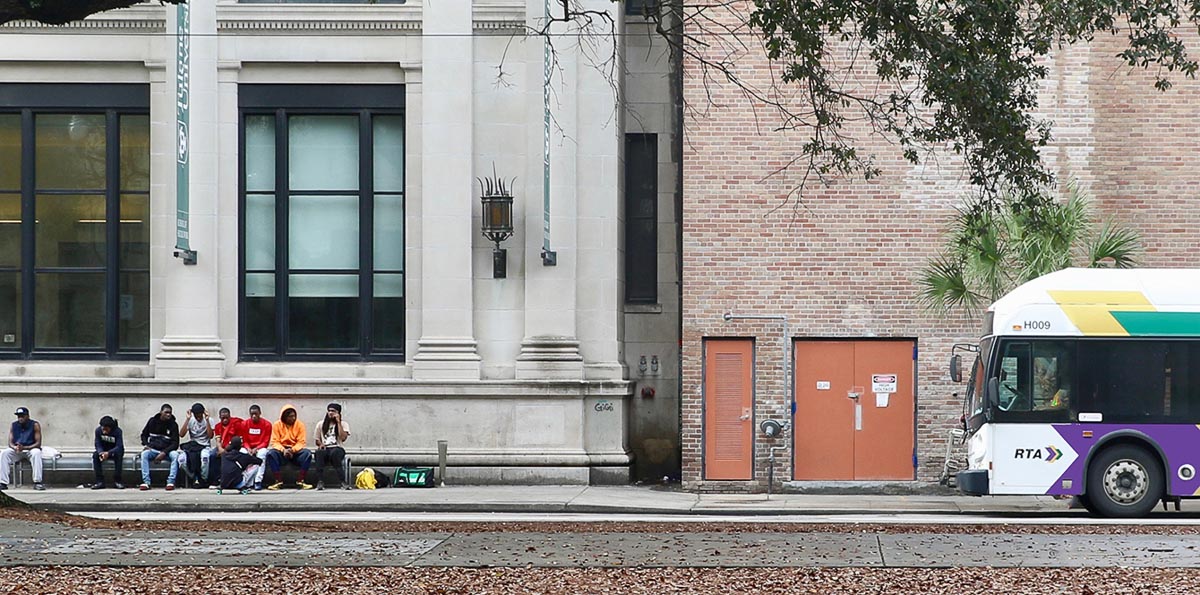“The first recommendation was to really recognize that urban design is not neutral. It either perpetuates or reduces social inequities within cities. And that is very hard for people to wrap their minds around because urbanists are taught that they are good, that they make communities better, and that they are the bringers of solutions.”
– Jay Pitter, @Jay_Pitter (talking with Orlando Bailey, Tamika Butler, Anthonia Ogundele, and Will Prosper at the Canadian Urban Institute.)
At West Bellfort, off the Southwest Freeway near the Fort Bend County line, passengers heading Downtown have a choice: A 30-minute ride on a Park and Ride bus for $3.25, or an almost-one-and-a-half-hour ride on a local bus for $1.25.
The Park and Ride bus has plush reclining seats, designed for comfort. It gets on an HOV lane separated from regular traffic. All of the Park and Ride stops outside Downtown have a canopy and seating for waiting passengers.
Read our series examining the intersection of race, equity and public transit in America, featuring insights from transit advocates and experts.
Part 1: “Racism has shaped public transit, and it’s riddled with inequities”
Part 2: “What transit agencies get wrong about equity, and how to get it right”
Part 3: “What transit equity means to a transit-dependent rider in a car-centric city”
Part 4: “To tackle pandemic racism, we need to take action, not just take to social media”
The local bus has plastic seats, designed to be easy to clean. It will bump along on local streets, delayed by traffic lights and cars turning into driveways. Some of its stops are no more than a sign on a narrow sidewalk, where waiting passengers will find neither shade nor a place to sit.
The Park and Ride offers a great experience, an experience made possible by massive public investments and by a per-ride subsidy that’s higher than the local bus network. The local bus is minimally adequate. The ridership on the park and ride buses is 60% white. The ridership on the local buses is 60% Black. This is not a coincidence.
The reality is that transit agencies are still managing and operating systems that have racism embedded in them. They have inherited past decisions, entrenched systems and ways of thinking. They’ve operated in a world full of racist policy — such as deed restrictions, zoning and mortgage lending policies designed to keep the suburbs white. In the United States, race has always been a part of transit. Even decisions that seem to be about technology can have racist outcomes — and sometimes those outcomes are intentional.
I’m not singling out any one transit agency here; the West Bellfort example in Houston is the norm for the transit world. I’m not singling out transit, either. All forms of transportation have been used to enable and implement racism. Highways were bulldozed through Black neighborhoods to enable segregated suburbs. Traffic laws are often used by police as a pretext to pull over and search people of color. Projects that claim to enhance “walkability” sometimes have unstated goals of gentrification. Port facilities and railroads put disproportionate burdens on Black and Hispanic neighborhoods.
Transit agencies, in fact, tend to be much more thoughtful about their impacts on people of color than other part of government. There are few agencies that don’t talk about diversity, equity and economic opportunity. Transit planning explicitly considers impacts on minority neighborhoods, and every service change comes with a Title VI analysis. Transit agencies are full of people who genuinely want to be part of the solution, and these agencies tend to believe they are helping people of all races lead better lives.
I count myself among this group. I’ve been a transit board member, leading a transit network redesign at Houston METRO. As a planning consultant, I’ve worked with agencies in Boston and Fort Worth. I wrote a book about transit in the United States. I strongly believe that better transit can make better cities.
But, through these experiences, I’ve seen how racism is embedded in nearly every planning discussion in America — often hiding beneath the surface. I’ve seen that transit often enables and supports racist systems. That won’t come as news to the many Americans who have lived with this reality every day since childhood. I’m not an expert on equity or a historian of race, and I know my own experience as a white man is very different from most of the people who ride transit in Houston. I definitely can’t say I’ve always gotten it right. But this is something we all have to think about and call out. So, in that spirit, I offer this piece — as one limited perspective that hopefully adds something to a much larger discussion.
We in the transit world, all of us who are involved in decisions about what kind of transit service to provide, and where and how to provide it, are the stewards of systems that have racism deeply rooted in them. And, unless we step back and question ourselves, are willing to have uncomfortable conversations, and share our power, we will continue to perpetuate that racism.

Agencies created in a segregated world
I think that much of how we think about transit in the United States today — and that bus service at West Bellfort comes from how transit agencies were created in the 1960s, ‘70s and ‘80s. Transit agencies are shaped by the world they were created in — the era of the re-segregationist response to the civil rights movement, an era that profoundly shaped our cities.
In this world, “urban” meant Black; “suburban” meant white. Urban areas were declining; suburbs were booming. Urban areas seemed dangerous; suburbs seemed safe. Downtowns were struggling to stay relevant; malls, business parks and corporate campuses in the suburbs were the future. (This way of looking at the world is, of course, still common.)
Most existing transit systems were urban and carried a relatively low-income and disproportionately Black ridership. Transit, which prior to WWII had been for everyone (and had in fact been a major driver of suburbanization), was now largely perceived as a mode for poor people in big cities.
Transit agencies were created as a response to two different problems: existing transit operations were going bankrupt (risking stranding the urban Black riders), and highway congestion was increasing (requiring new options for suburban white car commuters.)
METRO’s 1978 founding plan, for example, noted that transit “would continue to deteriorate” without public funding, and that “it takes twice as long to drive to work as it did 10 years ago,” and stated that METRO would: “Provide basic public transportation to those without other means of travel. And make public transit a convenient and attractive alternative to the private auto.”
These two problems fit neatly into a widespread way of thinking about public spending. The suburbs were only made possible by massive public investment in freeways, infrastructure and mortgage guarantees, while the government was underinvesting in urban neighborhoods and making it harder for their residents to buy homes. Yet, funding for urban areas was called bailouts or welfare, intended to “save” them and stop decline. Funding for suburban areas, on the other hand, was called investment, or necessary infrastructure for growth.
Different standards for so-called ‘dependent’ and ‘choice’ riders
That dual mandate never really got reconciled in the world of transit, and it still shapes the transit we operate today. It’s often expressed in terms of “dependent” and “choice” riders — terms that sound neutral (even thoughtful) but can lead to policy with racist impacts. It’s a pejorative, dated and inaccurate way of thinking about transit ridership — but it has profoundly shaped our transit networks.
For the “dependent riders,” transit agencies preserved and somewhat expanded urban bus (and sometimes rail) systems. But “dependent” meant they weren’t going to be picky — the primary emphasis here was on providing service, not providing a good experience. For the “choice riders,” however, agencies needed to provide great service — shiny new rail lines, and limited-stop express commuter buses — that had to be fast, reliable, comfortable and safe to get people out of their cars.
As a result of this dual mandate, many agencies essentially built and operated two systems with different standards for amenities, service levels and levels of subsidy.
It’s easy to talk about this as a bus/rail divide, but it’s not that simple. There are rail lines that are designed for “transit-dependent” riders, and there are bus routes designed for “choice” riders. This is about intent, not technology.
It’s a transit planning and operations strategy built around the idea that there are two types of riders, one (assumed to be white) who needs (and deserves) great service because they have a choice, and another (largely Black) who doesn’t need anything beyond the bare minimum.
This is obvious in how transit is funded and built. We can see it in infrastructure. We can see it in where cities invest their resources.

In Denver, an expensive light rail line was built for low ridership suburban routes while the city’s busiest transit route — where the higher capacity of rail would have had the most benefit — is a bus in mixed traffic.
Denver built expensive light rail for low ridership suburban routes while the busiest transit route in the city — where the higher capacity of rail would have the most benefit — is a bus in mixed traffic. The condition of a typical bus local stop in America — often without a bench, a shelter or an ADA boarding pad, even though none of these are expensive compared to what we spend on other transportation projects — shows well that agencies (and cities) don’t really care about “dependent riders.” Suburban park and ride lots, though, always have canopies to shade waiting riders or shelter them from rain.
We can see it in equipment. We can see it in service planning.
Agencies typically plan service so that every commuter rail rider gets a seat, while buses are planned to be standing-room only at rush hour.
But the distinction between “choice riders” and “dependent riders” goes beyond how we spend money.
Designing and policing for ‘white comfort’
Transit agencies concluded that to attract “choice riders” they needed to design for (as @DrDesThePlanner incisively puts it) “white comfort.” Those choice riders come to board meetings and talk about wanting to feel safe. Choice riders don’t want to be around vagrants or people who seem “sketchy.” (And we all know what that can be code for.)
Transit agencies have realized that the places they want to extend service to reach those “choice riders” are afraid of the “dependent riders.” In Maryland, the Anne Arundel County Executive formally asked the transit agency to shut down two light rail stations and run only peak service (for white-collar office workers) at two others because local residents claimed that “drug addicts, crooks, thieves,” use the stations to “go out there, rob the people, hop on the train back to Baltimore City.”
So many transit agencies have designed their systems to deliberately separate riders. In some cities, commuter buses and local buses often stop on different streets once they get to downtown areas, at different stops. Across the country, transit agencies operate local buses parallel to commuter rail at different fares, effectively providing one transit network for “choice riders” and another for the “transit dependent,” even where it would cost less to provide a single service at the lower of the two fares.

The same thinking shows up in system planning. In Oakland’s San Antonio — the most racially diverse neighborhood in the city, and one of the densest parts of the Bay Area — BART trains run nearly 3 miles without stopping. In suburban Walnut Creek and Pleasant Hill, less than half as dense, BART stations are only 1¾ miles apart. BART was literally designed (in the late 1960s) to speed white suburban commuters past Black inner-city residents.
And then, to make choice riders feel comfortable, agencies use police. In Maryland, the immediate response to suburban residents worried about crime was local policing boarding 1,000 trains — which, in all, resulted in 14 citations and three arrests. Armed police are not the only way to keep riders safe. Regular transit riders know how good bus drivers can be at dealing with unruly riders and keeping their passenger safe, all without weapons or the authority to make arrests. Unarmed fare enforcement officers are quite effective, as are outreach teams that try to help, rather than punish, the homeless. Yet, across the country, transit agencies have been increasing police patrols on trains.
In 2019 — with crime at record low levels — New York City decided to add another 500 officers to the 2,500 already patrolling the subway. We know — from data and the experience of riders — that policing is racist. Police are deployed more often in Black neighborhoods, stop Black riders more often (only 12% of BART riders are Black, but 50% of BART police “code of conduct” citations are issued to Black riders), and disproportionately kill Black people. We have seen many instances of people of color being violently attacked by police for minor infractions like selling food on a subway platform. White riders are likely to see a police officer on a train as a comforting presence while many Black riders justifiably will perceive them as a potential threat.
These decisions may seem to be decisions about planning and operations. Fare structures can be useful ways to manage demand and account for the cost of providing trips. Crowding does work differently on short trips than long ones. Agencies need to be concerned about the safety of their riders. Too many stations do slow down transit. However, the way in which these decisions have been made often has had racist outcomes.
Transit systems have racism built into their schedules, their fleets, their route structures and their infrastructure.
Structural racism in transit agencies
Of course, many agencies also have racism built into their governing structure. Why do suburban areas often have separate agencies from their big cities? There are legitimate reasons for this, but it seems to happen a lot in areas where cities have largely Black populations and suburbs are predominantly white. In Detroit, not only do the suburbs have their own agency that excludes the city, but by policy those buses will not pick up Detroit residents as they pass through the city.
Every transit line, every bit of infrastructure, every bus that runs down a street and every train that runs down a track does so in pursuit of a motive. We can’t be neutral experts; we have to ask what those motives are. There are many — what I’ve talked about here is only one aspect of how transit represents larger political goals, and only one dimension of how race and transit intersect. For example, the elevation of the idea of transit as a development tool has put some transit agencies into the role of gentrifiers.
For example, one of the visioning efforts that prompted the construction of the Cincinnati Streetcar stated that “streetcars in other cities have been shown to bring new people to an area. Streetcars attract people who don’t ride buses. They are popular with young professionals, who tend to live in and near urban areas.” The neighborhood the streetcar serves is 70% Black, with a median household income under $15,000. The streetcar wasn’t designed to serve those residents — it was designed to displace them. There’s nothing inherently racist about steel rails, overhead wire and low floor articulated vehicles. But those technologies, like all technologies, can be used to racist ends.
Transit agencies absolutely can be powerful tools for equity. A good transit network opens up a metropolitan area — and its jobs and opportunities — for all of its residents. At its best, transit includes everyone. We can absolutely design a transit system that’s great for all people, whether they have access to a car or not. METRO, in fact, is working on that: the METRONext plan includes a program called “BOOST” that will transform local bus routes into faster, more reliable, and more comfortable service. It promises to dramatically improve the rider experience in places like Sunnyside. The plan also includes a reimagining of the park and ride network into a system of regional services that could better integrate with the local buses, run both ways all day, and serve more than just 9-to-5 white-collar commuters. Houston’s transit system could become a better experience for everyone.

Let’s do the hard work required to achieve transit equity
But to build more equitable networks, we in the transit world have to be thoughtful about what we do. We need to ask what we’re doing that perpetuates structural racism. That means rejecting “we’ve always done it that way” as an answer because we know what we did in the past was part of racist systems. Why does every rail station get a shelter and not every bus stop? “That’s the standard” is not an answer.
To build more equitable transit, we have to recognize that transit fits into larger systems. We can’t talk about fare enforcement without thinking about policing in general. We can’t predicate service on “transit-friendly land use” without accounting for the fact that redlining, highway construction, pollution and systemic disinvestment have left many Black residents living in places that aren’t walkable or dense.
Making transit equitable requires us to question how we make decisions. It means being willing to call out decision-makers — when we see elected officials and other agencies asking for racist policy, we should not simply defer to their requests. It means being willing to call out partners — the city that does not want to provide street space for a decent bus stop is part of the problem.
Making transit equitable means listening to all riders and all communities, not just the people who have the time (and confidence in their influence) to show up at a board meeting. It means having boards and senior management teams that actually reflect the diversity of riders and cities. Token representation isn’t enough, and true inclusion requires cultural change, not expecting people of color to adapt to the way systems that historically have excluded them operate.
Above all, addressing racism requires all of us affirmatively trying to be part of the solution, not just doing what’s comfortable and congratulating ourselves for how equitable we are. We have to confront the embedded racism of our transit systems. We can’t leave it to people of color or the “equity person” to speak up.
We need to realize that, just because we are trying to make transportation better, we are not automatically the good guys. We are not always the “bringers of solution.” We all have to be willing to talk about race — whether it makes us uncomfortable or not — and then follow through on what we learn.
Christof Spieler is a vice president and director of planning at Huitt-Zollars, a senior lecturer at Rice University, and author of “Trains, Buses, People: An Opinionated Atlas of US Transit,” published by Island Press in 2018. He served as a member of the Harris County Metropolitan Transit Authority’s board of directors from 2010 to 2018.

